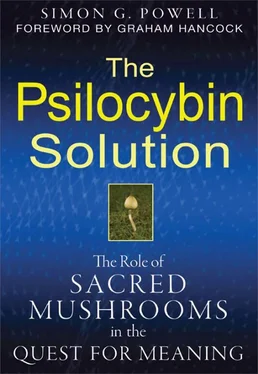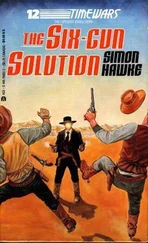On the aforementioned coronation of Montezuma, Durán tells us:
The sacrifice finished and the steps of the temple and patio bathed in human blood, they all went to eat raw mushrooms; on which food they all went out of their minds, worse than if they had drunk much wine; so drunk and senseless were they that many killed themselves by their own hand, and, with the force of those mushrooms, they would see visions and have revelations of the future, the Devil speaking to them in that drunken state. {5} 5 2. Ibid., 202.
Because of his own personal experiences with psilocybin, and in light of historical research that clearly showed the Aztecs’ reverence for teonanácatl, our mushroom expert Wasson came to the conclusion that Durán had imposed his own views on the matter in order to further demonize the mushroom practice. Which is to say that to identify the Devil at the heart of the psilocybin experience was an interpretation peculiar to the psyche of this sixteenth-century friar. With his particular theological training he would have had no choice but to sniff the sulphurous traces of the Devil in the Aztecs’ unusual entheogenic rites. Durán’s perception of psilocybin-inspired suicides within the Nahuatl texts is therefore more likely to be the result of bias and exaggerated translation than actual fact. Today’s tabloid press would doubtless be impressed by Durán’s sensational rhetoric.
Another friar, the Franciscan Bernardino de Sahagún, also left us an account of native mushroom use. In the Florentine Codex he writes of a merchant’s celebration.
At the very first, mushrooms had been served. They ate them at a time when, they said, the shell trumpets were blown. They ate no more food; they only drank chocolate during the night. And they ate the mushrooms with honey. When the mushrooms took effect on them, then they danced, then they wept. But some while still in command of their senses entered and sat there by the house on their seats; they danced no more, but only sat there nodding. {6} 6 3. Ibid., 206.
On the face of it, this would seem to be a less prejudiced portrayal of psilocybin use, though in the following report, also by Sahagún, he soon slides into the familiar tabloidlike sensationalist mode while describing mushroom use.
It is called teonanácatl . It grows on the plains, in the grass. The head is small and round, the stem long and slender. It is bitter and burns; it burns the throat. It makes one besotted; it deranges one, troubles one…. He who eats many of them sees many things which make him afraid, or make him laugh. He flees, hangs himself, hurls himself from a cliff, cries out, takes fright. {7} 7 4. Ibid., 206–7.
Such scare stories are echoed by the rumors that surrounded LSD use in the 1960s. People were supposedly hurling themselves from high-rise apartments and foolishly attempting to stop highway traffic by the power of thought alone. In actuality, of all the millions of doses of LSD taken in the 1960s, there were only a handful of deaths through misadventure resulting from LSD’s effects. It appears that any psychedelic substance with a powerful mystique seems to instill fear in those who are unfamiliar with its effects and who are easily threatened by the unknown. Moreover, fear often precedes persecution and the spreading of inaccurate information, which is why it is so important to have an unconditional flow of informed, hysteria-free knowledge regarding the psychological action of visionary plants and fungi. One hopes, then, that we live in more enlightened times. The fact remains, however, that the Aztec use of psychoactive agents, which included the use of other entheogens like the morning glory plant (whose seeds contain LSD-related compounds), proved to be so abhorrent to the Spanish that they sought to drive all such practices to extinction.
That they were successful in forcibly burying the mushroom is made clear by the academic events in the early part of the last century, as it was erroneously believed that there never were any psychoactive mushrooms to be found in Mexico in the first place. It was assumed by scholars that a mistake had been made by the obviously dim-witted Spanish historians, and that dried peyote cactus buttons (containing the entheogenic alkaloid mescaline) were the legendary teonanácatl. This botanical conjecture, or blunder as it was, went completely unchallenged by the academic fraternity when it was presented in 1915, and it remained unchallenged until a species of psychoactive mushroom still being used in Huautla was identified in 1938.
Perhaps, then, we should conclude that mycophobia is not merely a cultural phenomenon, but a remorseless genetic trait. This is an idea that Wasson would certainly have appreciated, as he was to come across much in the way of scholarly disregard for psilocybin’s religious role within ancient Mesoamerican culture. It is only since Wasson’s work has come to be acknowledged that historians have begun to realize that psychedelic agents like the Mexican mushroom have the power to move people, that their tremendous psychological impact was significant in shaping the belief systems of those cultures that used them. The point that Wasson was continually at pains to make was that one should be wary of underestimating the cultural and historical role of entheogenic flora, although, of course, he came to this conclusion by way of his own personal psychedelic experiences. Alas, such personal insights are not shared by most other Mesoamerican scholars.
One of the most remarkable pieces of evidence testifying to the exalted status conferred upon the psilocybin mushroom by the Aztecs is in the form of an early sixteenth-century statue of the god Xochipilli, or the “Prince of Flowers.” The significance of this magnificent piece of art was first recognized by Wasson, and thereafter the real message that it conveyed became glaringly apparent.
The statue represents a cross-legged male figure—the god Xochipilli—caught up in an ecstatic trance. There can be no mistake. The very essence of ecstasy has been captured in stone. The arms, legs, and base of this stone-carved ecstatic prince carry stylized engravings of flowers, and on each of the four sides of the base of the statue are carved mushroom motifs. These mushroom motifs also appear upon the subject so enraptured.
Until these carvings came under the attentive gaze of Wasson, they had never been botanically identified. Wasson realized that the stylized flowers were the key to deciphering the true meaning of the Aztec statue and, moreover, the very meaning of “flowers” in classic Aztec literature. As soon as Wasson intimated the statue’s full raison d’être, he immediately contacted noted ethnobotanist Richard Evans Schultes at Harvard’s Botanical Museum, who was the obvious man to consult regarding a botanical analysis of the motifs.
Schultes was subsequently confident enough to identify the carved “flowers” as Nicotiana tabacum, the common tobacco plant considered sacred by almost all native American cultures; Turbina corymbosa, a species of morning glory whose psychoactive seeds are known to have been employed by Mesoamerican cultures; and Heimia salicifolia, also a psychoactive species. Wasson noted that these species were representative of the Aztecs’ most revered plants, hence there were no depictions of less-esteemed plants such as those employed by the Aztecs to make maize beer.
Wasson believed that previous ignorance of the statue’s true nature reflected the aforementioned widespread failing of historians to acknowledge the important role that psilocybin mushrooms and other sacred flora played in Mesoamerican history. In The Wondrous Mushroom, Wasson writes: “Our statue of Xochipilli serves us as a touchstone, as a cultural Rosetta Stone, bypassing the friars encumbered with their theological preconceptions, speaking to us directly with the voice of the pre-Conquest Aztecs.” {8} 8 5. Ibid., 73.
Читать дальше










